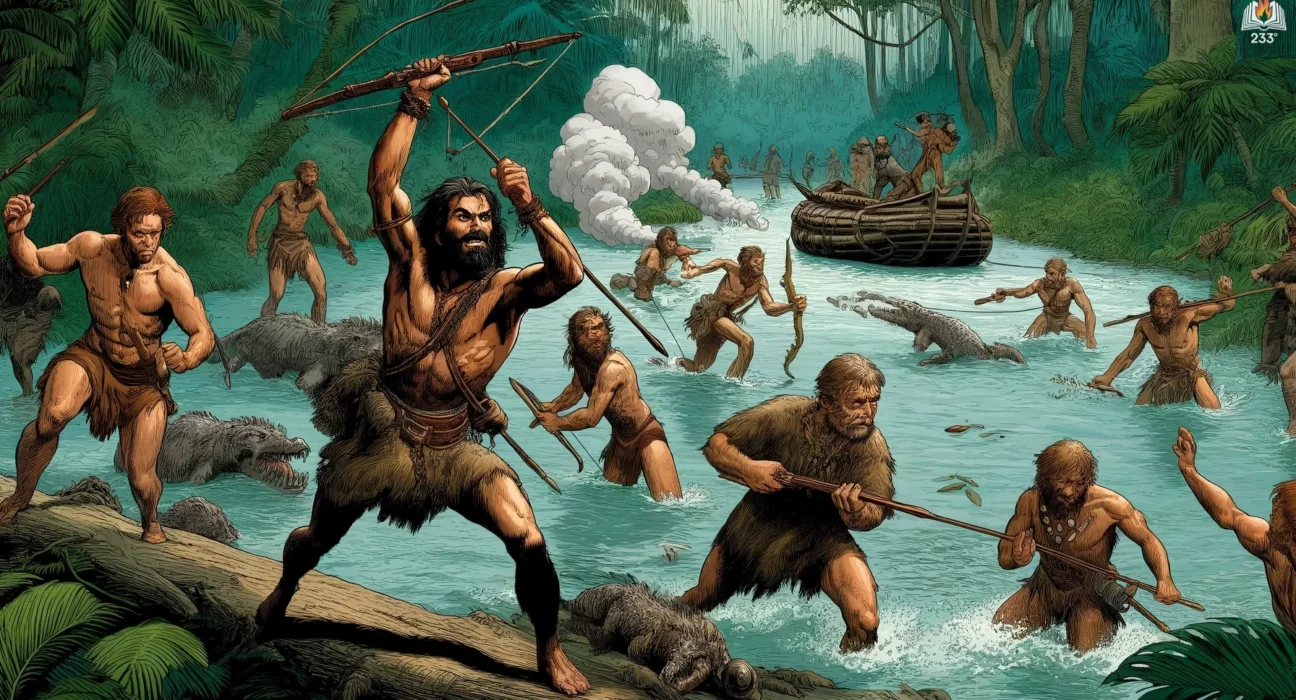“Land of Terror,” written by Edgar Rice Burroughs, is the sixth book in the Pellucidar series. Published in 1944, this science fiction novel continues the adventures of David Innes, who explores the prehistoric inner world of Pellucidar. The book showcases Burroughs’ signature blend of action, adventure, and imaginative world-building, set against the backdrop of a primitive land filled with strange creatures and fierce tribes.
Plot Summary
David Innes had lived in the world of Pellucidar for what seemed like an eternity. Thirty-six years had passed since he and Abner Perry tunneled through the Earth’s crust into this strange inner world. Time flowed differently here, or rather, it didn’t seem to flow at all. With the sun perpetually fixed in the sky, marking the passage of time became meaningless. Though years had passed, David still looked as youthful as the day he first arrived, a product of Pellucidar’s eternal present.
In this land untouched by the outer world’s advancements, David and Perry had managed to introduce some elements of modern civilization. They built weapons, crafted ships, and even established a primitive navy that allowed them to dominate the seas and bring some semblance of order. They had become reluctant pioneers, bringing the gifts and curses of technology to a world where men still fought with stone weapons. Their presence had a profound impact, but it also brought new dangers. Now, with firearms and even poison gas experiments in progress, the tribes of Pellucidar were on a path of rapid and often brutal change.
David set out on a new expedition, his goal to find his missing friend, von Horst. Accompanied by a group of Sarians armed with the rifles Perry had designed, they journeyed across uncharted lands, through lush forests and vast plains where prehistoric beasts roamed freely. This was a world of wonder and danger, where creatures like mammoths and sabre-tooth tigers were a common sight. David was filled with a mix of awe and exhilaration as he ventured into territories no human from the outer world had ever seen.
Their journey brought them to a wide river, its sluggish current hiding deadly carnivorous reptiles beneath its surface. While they were constructing rafts to cross, they were ambushed by a group of bearded warriors. These warriors were fierce, using primitive slingshots to hurl dart-like missiles at David and his men. Despite their rifles, the fight was brutal, and David found himself on the losing end. He was captured, knocked unconscious by the choking smoke bombs thrown by the attackers.
When he awoke, David found himself bound and lying in the bottom of a canoe. He soon realized that his captors were not men, but women—strong, bearded women warriors. They belonged to the village of Oog, where the roles of men and women were reversed. Here, the women were the hunters and warriors, while the men were subjugated and forced into domesticity. Brought before their chief, Gluck, David was questioned about the mysterious “magic” that allowed his sticks to spit fire and death. Thinking quickly, he described it as a power only known to the men of Sari, a secret that could not be shared.
Assigned to work in the fields, David was placed under the watchful eye of Glula, a small, effeminate man who served the warrior women. He quickly learned the harsh reality of life in Oog, where the men lived in fear of their powerful female masters. Despite the oppressive conditions, David befriended another captive, Zor. Zor shared his own tale of loss and captivity, having ventured far from his home in search of a loved one, only to be captured by the women of Oog. Together, they hatched a plan to escape, though the possibility seemed remote.
The opportunity for freedom came unexpectedly when the village of Oog was attacked by a rival tribe, the Juloks. These women rode into battle on Dyals, giant flightless birds with powerful talons and beaks capable of tearing apart their enemies. The scene was chaotic, smoke and shouts filling the air. David and Zor saw their chance amidst the confusion. They seized an abandoned Dyal and mounted it, spurring the creature into a frenzied escape. The bird sped through the landscape, carrying them far from the reach of their captors.
Their escape took them to the snow-capped peaks of a mountain range. The Dyal, unused to the cold and treacherous terrain, refused to go further, forcing David and Zor to continue on foot. As they descended into a forested valley, they were attacked by a tarag, a monstrous sabre-toothed tiger. They barely escaped with their lives, taking refuge in the trees until the beast lost interest. Realizing they needed better weapons to survive, David crafted a bow and arrows, while Zor fashioned a spear. These weapons would be their means of protection and their ticket to survival in this dangerous world.
As they ventured further, they came across the territory of the Jukans, a tribe known for their erratic and unpredictable behavior. The Jukans captured them and brought them to the village of their king, Meeza. The village was a place of madness, where rituals and daily life were governed by the whims of their leaders and the grotesque idol they worshipped, Ogar. David and Zor witnessed disturbing scenes, like a mother attempting to kill her child under the belief it was the only way to cure its mysterious ailment. The Jukans oscillated between hospitality and violence, making it clear that their survival depended on navigating this strange society with the utmost care.
Taken before Meeza, David and Zor were forced to partake in bizarre activities meant to honor Ogar. They were told to make mud pies, an act the Jukans considered sacred and full of significance. It was a test of their willingness to conform to the strange customs of this tribe, a test that could mean the difference between life and death. Through it all, David remained focused on finding a way to escape this nightmare and return to Sari. His determination was unshakable, even in the face of madness.
The day of their escape finally arrived. In the midst of another attack by the Juloks, David and Zor once again seized the opportunity. They fled during the chaos, heading towards the mountains and the promise of freedom. Their journey was far from over, with dangers lurking at every turn, but David’s resolve was stronger than ever. He knew that to survive in Pellucidar, one had to be as relentless and untamed as the land itself.
Main Characters
David Innes: The protagonist and narrator, David is a brave and resourceful adventurer who has spent thirty-six years in Pellucidar. He embodies the spirit of exploration and resilience, continually striving to bring civilization to the primitive inner world.
Abner Perry: David’s loyal companion and a brilliant scientist, Perry has invented various technologies to aid their survival and progress in Pellucidar. His experiments with gunpowder and other innovations are crucial to their efforts.
Gluck: The formidable chief of the warrior women of Oog, Gluck is a brutal and powerful leader who rules over her tribe with an iron fist. Despite her savagery, she shows a begrudging respect for David’s strength.
Zor: A fellow captive from the village of Zoram, Zor becomes David’s close ally and friend. He shares his tragic backstory and his determination to escape the clutches of their captors.
Theme
Civilization vs. Savagery: The novel explores the contrast between the primitive world of Pellucidar and the advancements of modern civilization. David and Perry’s efforts to introduce technology and social order highlight this central theme.
Gender Roles and Power Dynamics: The reversal of traditional gender roles in the village of Oog serves as a commentary on power dynamics and societal structures. The subjugation of men by warrior women challenges conventional norms and raises questions about equality and dominance.
Survival and Adaptation: The characters’ ability to survive and adapt to the harsh environment of Pellucidar underscores the theme of resilience. David’s ingenuity in creating weapons and navigating dangerous situations illustrates human adaptability.
Adventure and Exploration: The thrill of discovery and the allure of uncharted territories drive the narrative. David’s passion for exploration and his encounters with unknown creatures and lands reflect the adventurous spirit at the heart of the story.
Writing Style and Tone
Edgar Rice Burroughs’ writing style in “Land of Terror” is characterized by vivid descriptions, fast-paced action, and imaginative world-building. His prose is direct and engaging, effectively conveying the excitement and peril of the characters’ adventures. The tone of the novel is adventurous and thrilling, with a sense of wonder and discovery permeating the narrative.
Burroughs employs a first-person perspective, allowing readers to experience the events through David Innes’ eyes. This narrative choice adds immediacy and intimacy to the story, drawing readers into the world of Pellucidar. The dialogue is straightforward and often reflects the characters’ pragmatic approach to their challenges. Overall, Burroughs’ writing style and tone contribute to the immersive and captivating nature of the novel.
We hope this summary has sparked your interest and would appreciate you following Celsius 233 on social media:
There’s a treasure trove of other fascinating book summaries waiting for you. Check out our collection of stories that inspire, thrill, and provoke thought, just like this one by checking out the Book Shelf or the Library
Remember, while our summaries capture the essence, they can never replace the full experience of reading the book. If this summary intrigued you, consider diving into the complete story – buy the book and immerse yourself in the author’s original work.
If you want to request a book summary, click here.
When Saurabh is not working/watching football/reading books/traveling, you can reach him via Twitter/X, LinkedIn, or Threads
Restart reading!








